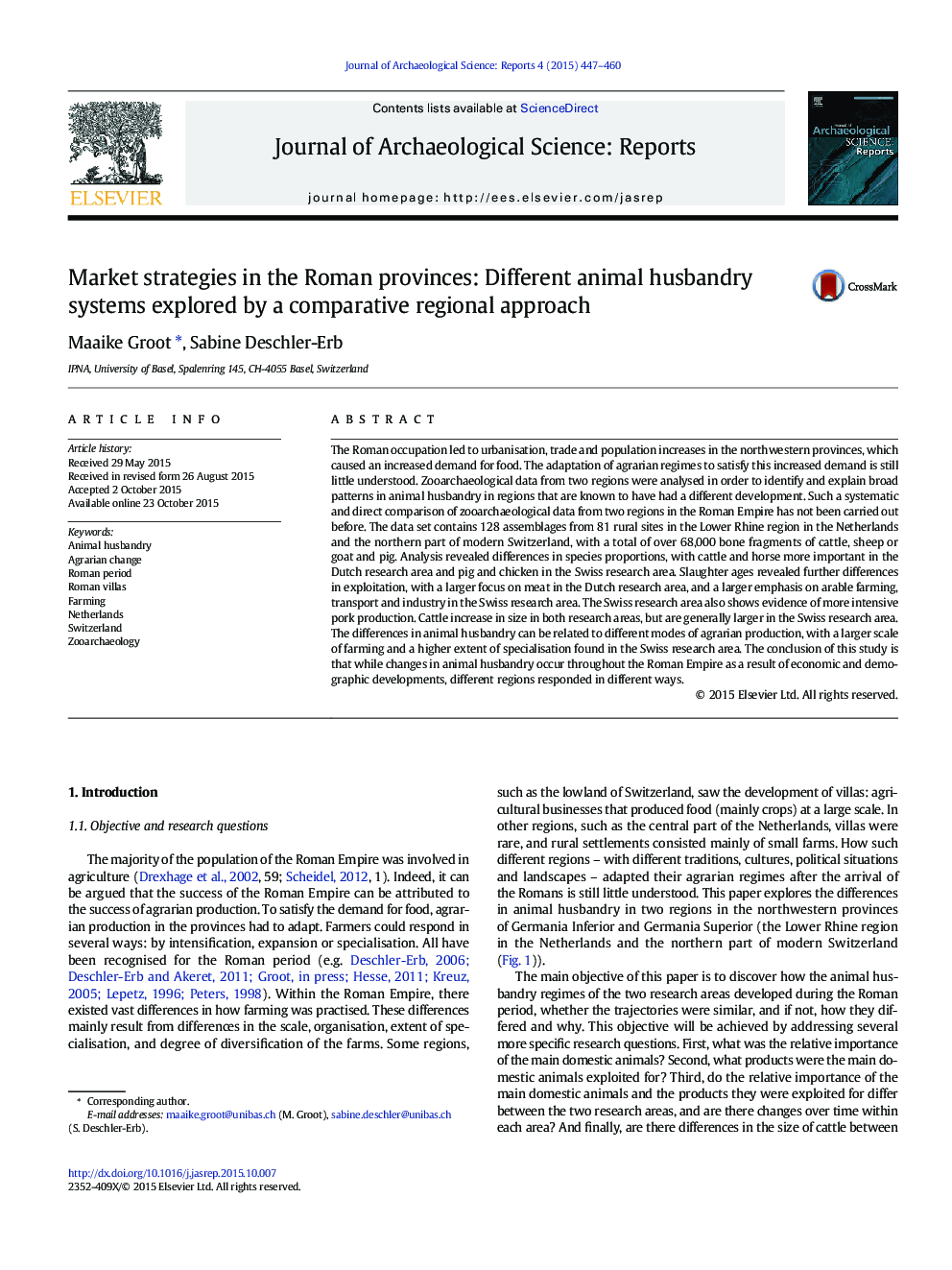| کد مقاله | کد نشریه | سال انتشار | مقاله انگلیسی | نسخه تمام متن |
|---|---|---|---|---|
| 7446386 | 1483939 | 2015 | 14 صفحه PDF | دانلود رایگان |
عنوان انگلیسی مقاله ISI
Market strategies in the Roman provinces: Different animal husbandry systems explored by a comparative regional approach
ترجمه فارسی عنوان
استراتژی های بازار در استان های رومی: سیستم های مختلف دامداری با استفاده از رویکرد منطقهای مقایسه شده است
دانلود مقاله + سفارش ترجمه
دانلود مقاله ISI انگلیسی
رایگان برای ایرانیان
کلمات کلیدی
دام پروری، تغییر زراعتی، دوره رومی، ویلاهای رومی، کشاورزی هلند، سوئیس، باغ وحش
ترجمه چکیده
اشغال روم به شهرنشینی، تجارت و افزایش جمعیت در استان های شمال غربی منجر شد که باعث افزایش تقاضا برای غذا شد. سازگاری رژیم های زراعی برای برآورده ساختن این تقاضای افزایش یافته هنوز درک نشده است. داده های زیست شناختی از دو منطقه به منظور شناسایی و توضیح الگوهای گسترده ای در حیوانات کشاورزی در مناطق شناخته شده است که توسعه های مختلف. چنین مقایسه ای سیستماتیک و مستقیم از داده های زیست شناسی از دو منطقه در امپراتوری روم قبلا انجام نشده است. مجموعه داده شامل 128 مجموعه از 81 محل روستایی در منطقه پایین ترین راین در هلند و بخش شمالی مدرن سوئیس است که مجموعا بیش از 68000 قطعه استخوان گاو، گوسفند، بز و خوک دارد. تجزیه و تحلیل نشان داد تفاوت در نسبت گونه ها، با گاو و اسب در منطقه پژوهش هلندی و خوک و مرغ در منطقه تحقیقاتی سوئیس مهم تر است. سیل کشتارها اختلافات بیشتری در بهره برداری را نشان می دهد، با تمرکز بیشتر بر گوشت در منطقه تحقیقاتی هلند و تأکید بیشتر بر کشاورزی، حمل و نقل و صنعت کشاورزی در منطقه تحقیقاتی سوئیس. منطقه تحقیقاتی سوئیس نیز شواهدی از تولید گوشت خوار را بیشتر نشان می دهد. گاوهای بزرگ در هر دو منطقه تحقیقاتی افزایش مییابند، اما در منطقه تحقیقاتی سوئیس عموما بزرگتر هستند. تفاوت های موجود در حیوانات کشاورزی می تواند به شیوه های مختلف تولید زراعتی بستگی داشته باشد، با مقیاس وسیع تر کشاورزی و میزان بالاتری از تخصص های موجود در منطقه تحقیقاتی سوئیس. نتیجه گیری این مطالعه این است که در حالی که تغییرات در دامداری در طول امپراطوری روم در نتیجه تحولات اقتصادی و جمعیتی رخ می دهد، مناطق مختلف به شیوه های مختلف پاسخ دادند.
موضوعات مرتبط
علوم انسانی و اجتماعی
علوم انسانی و هنر
تاریخ
چکیده انگلیسی
The Roman occupation led to urbanisation, trade and population increases in the northwestern provinces, which caused an increased demand for food. The adaptation of agrarian regimes to satisfy this increased demand is still little understood. Zooarchaeological data from two regions were analysed in order to identify and explain broad patterns in animal husbandry in regions that are known to have had a different development. Such a systematic and direct comparison of zooarchaeological data from two regions in the Roman Empire has not been carried out before. The data set contains 128 assemblages from 81 rural sites in the Lower Rhine region in the Netherlands and the northern part of modern Switzerland, with a total of over 68,000 bone fragments of cattle, sheep or goat and pig. Analysis revealed differences in species proportions, with cattle and horse more important in the Dutch research area and pig and chicken in the Swiss research area. Slaughter ages revealed further differences in exploitation, with a larger focus on meat in the Dutch research area, and a larger emphasis on arable farming, transport and industry in the Swiss research area. The Swiss research area also shows evidence of more intensive pork production. Cattle increase in size in both research areas, but are generally larger in the Swiss research area. The differences in animal husbandry can be related to different modes of agrarian production, with a larger scale of farming and a higher extent of specialisation found in the Swiss research area. The conclusion of this study is that while changes in animal husbandry occur throughout the Roman Empire as a result of economic and demographic developments, different regions responded in different ways.
ناشر
Database: Elsevier - ScienceDirect (ساینس دایرکت)
Journal: Journal of Archaeological Science: Reports - Volume 4, December 2015, Pages 447-460
Journal: Journal of Archaeological Science: Reports - Volume 4, December 2015, Pages 447-460
نویسندگان
Maaike Groot, Sabine Deschler-Erb,
